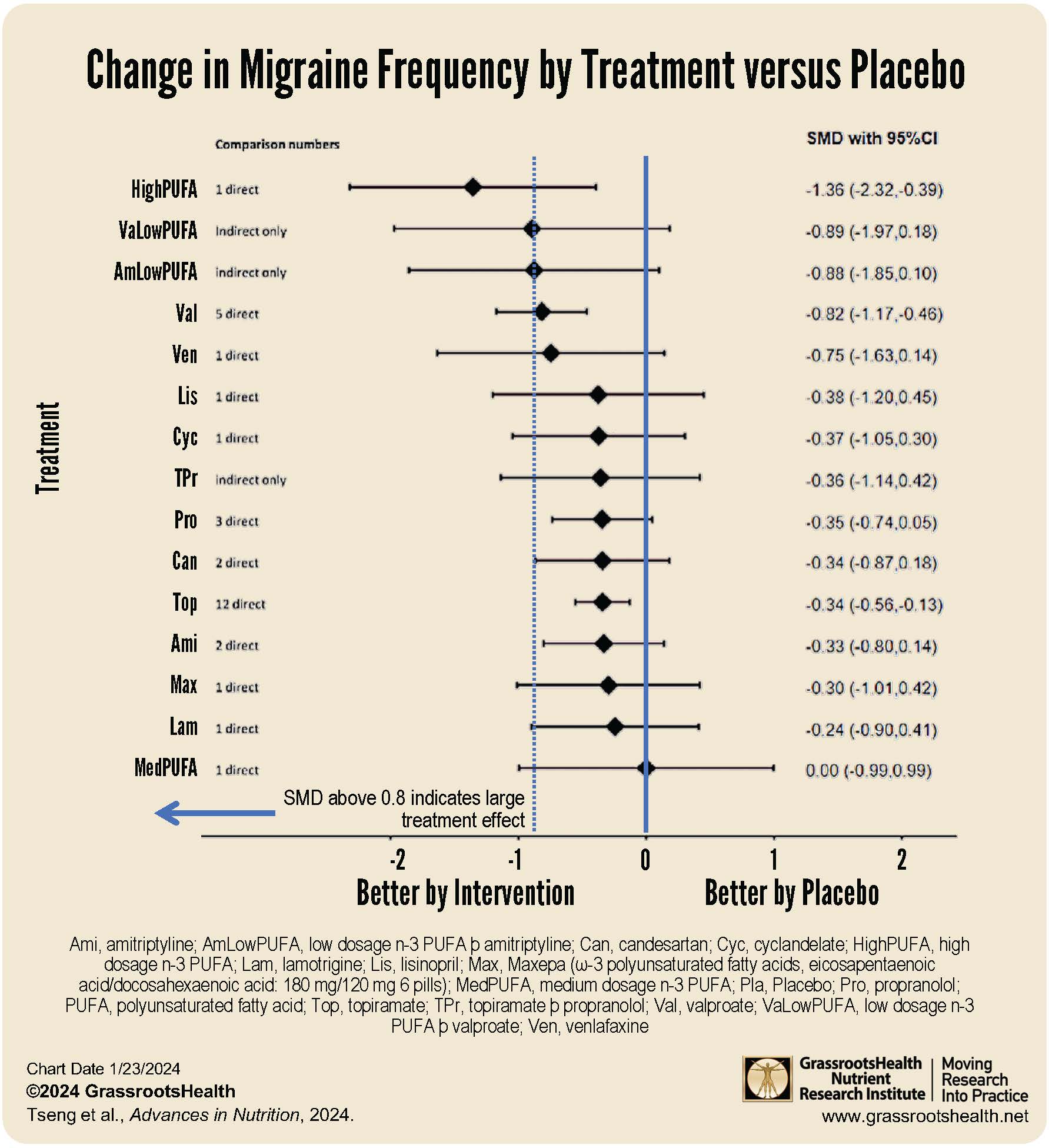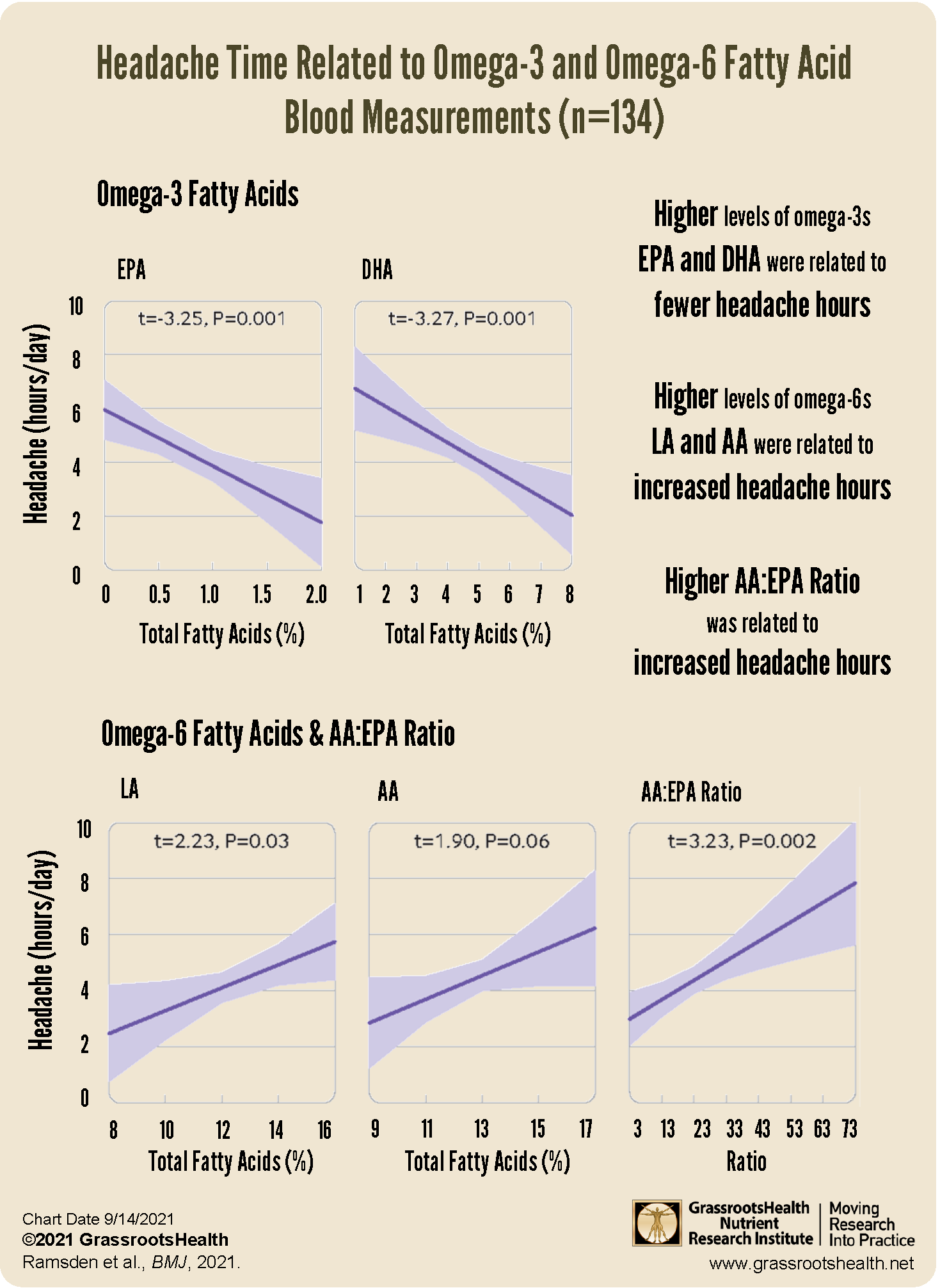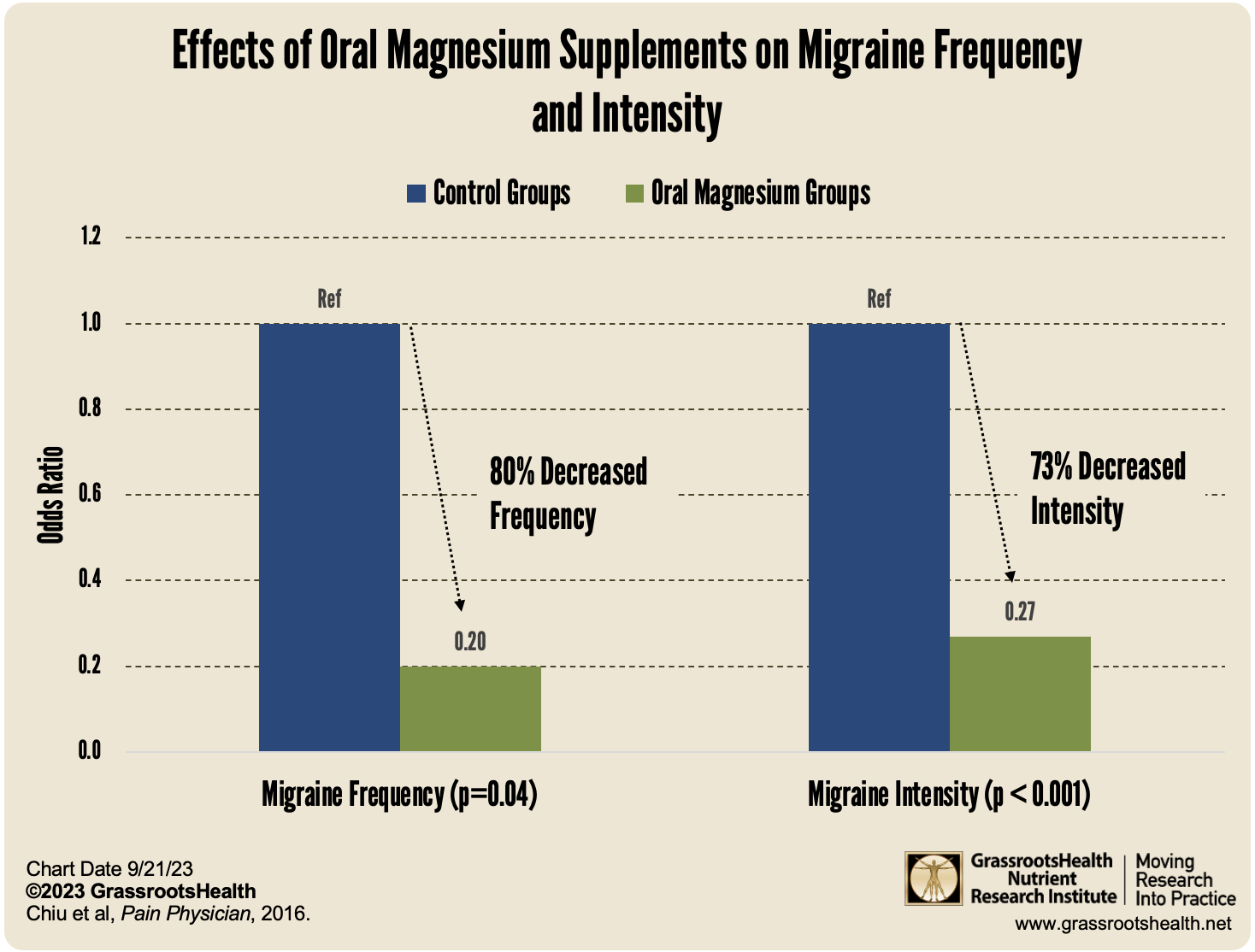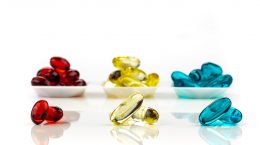Published on January 24, 2024
Data from 40 RCTs combined shows that high dose DHA+EPA was best at decreasing frequency and severity of migraines
Key Points
- A new network meta-analysis analyzed data from 40 randomized controlled trials (RCTs) involving participants with either episodic or chronic migraines; a total of 6,616 participants with an average age of 35 years old was included in the study
- The study found the highest decrease in migraine frequency and severity among those supplementing with high-dose EPA+DHA supplements (1500 mg/day of EPA+DHA or higher), as well as the best acceptability rates compared to other treatments
- A meta-analysis of 21 studies found that oral magnesium, used for migraine prevention, was found to significantly reduce the frequency of migraines by 80% and the intensity of migraines by 78%
How are Your Omega-3 Levels? Check Now and Save 15% with Code OMEGA3S!
 Migraines are among the most common chronic diseases worldwide, with many migraine sufferers experiencing high levels of pain and even disability, despite the use of medications. In fact, current pharmacologic treatments for migraine have been shown to have limited efficacy, poor response rates, and concerning safety profiles.
Migraines are among the most common chronic diseases worldwide, with many migraine sufferers experiencing high levels of pain and even disability, despite the use of medications. In fact, current pharmacologic treatments for migraine have been shown to have limited efficacy, poor response rates, and concerning safety profiles.
Eicosapentaenoic acid (EPA) and docosahexaenoic acid (DHA) are two omega-3 fatty acids that have shown promise in the treatment of migraines, likely due to their anti-inflammatory effects, actions on nociceptive responses (to reduce neuropathic pain), and their inhibiting effect on cerebral vasodilation. It is also known that omega-3 and omega-6 fatty acids are a major component of the tissues involved; for example, the omega-3 fatty acid DHA makes up approximately 8% of the weight of the brain! Previous research on the effect of EPA and DHA on migraines has demonstrated varying effectiveness based on the dose of DHA and EPA – a new network meta-analysis further supports this dose-dependent effect of DHA and EPA on migraines.
EPA+DHA Supplementation Associated with a Superior Prophylactic Effect on Migraine Frequency & Severity
A new 2024 network meta-analysis by Tseng et al. looked at data from 40 randomized controlled trials (RCTs) involving participants with either episodic or chronic migraines. A total of 6,616 participants with an average age of 35 years old was included; the average duration of treatment was 18 weeks. The primary goal of the analysis was to assess the effect of treatment, including different doses of DHA+EPA, on migraine frequency, treatment acceptability (how likely the participant was to stay on a specific treatment), response rates, frequency of rescue medication use, changes in migraine severity, and frequency of adverse events.
Data for EPA+DHA supplementation was divided into 3 groups based on dosage:
- EPA+DHA supplementation of less than 900 mg/day (LowPUFA)
- EPA+DHA supplementation between 900-1500 mg/day (MedPUFA)
- EPA+DHA supplementation of 1500 mg/day or higher (HighPUFA)
The study found the highest decrease in migraine frequency and severity among those supplementing with high-dose EPA+DHA supplements, as well as the best acceptability rates compared to other treatments.
For changes in migraine frequency, the following top treatments were significantly related to reduced frequency compared to placebo:
- High dose EPA+DHA supplementation (HighPUFA, SMD -1.36)
- Valproate (SMD -0.82)
- Topiramate (SMD -0.34)
The forest plot below illustrates these findings by showing the standardized mean differences (SMD) of migraine frequency for each treatment group compared to placebo. The ‘0’ line represents no effect while the points below 0 represent the amount of improvement with the intervention. As you can see, the HighPUFA group has the greatest beneficial effect among all treatment groups, and the effect is large.
The short video here does a great job of describing SMD and how to look at the forest plot for a better understanding of the results. (Skip ahead to 3:12 to get straight into SMD) The video highlights cut-off points of 0-0.2 as being a small effect, 0.2-0.8 a moderate effect, and anything greater than 0.8 a large effect.
For changes in the severity of migraine attacks, the following top treatments were significantly related to reduced severity compared to placebo:
- High dose EPA+DHA supplementation (HighPUFA, SMD -2.23)
- Medium dose EPA+DHA supplementation (MedPUFA), SMD -1.28)
- Valproate (SMD -1.00)
- Topiramate (SMD -0.32)
As the authors state,
“Based on 40 randomized controlled trials and 6616 participants, high dosage prophylactic EPA/DHA supplementation can be considered a first-choice treatment of migraine prophylaxis because this treatment displayed the highest efficacy and highest acceptability of all studied treatments… as compared with other FDA-approved/guideline-recommended medications.”
Increased Omega-3 Intake Shown to Reduce Headache Frequency and Severity
A previous study by Ramsden et al. found that both intake and blood levels of omega-3 and omega-6 fatty acids significantly affected migraines; specifically, participants experienced fewer hours of headache per day as blood levels of EPA and DHA increased and as LA and the AA:EPA ratio decreased.
Magnesium Significantly Reduced Migraine Frequency by 80% and Intensity by 78%
Studies have shown that magnesium can help relieve migraine symptoms and reduce their frequency. A 2016 meta-analysis of 21 studies found that intravenous magnesium significantly alleviated acute migraine symptoms by about 75% both immediately (15-45 minutes) and longer term (24 hours). Oral magnesium, used for migraine prevention, was found to significantly reduce the frequency of migraines by 80% and the intensity of migraines by 78%.
Migraine and Cluster Headaches Helped with Vitamin D
The “Vitamin D Anti Inflammatory Regimen,” discussed in this video interview with Dr. Bruce Holis, has helped many to successfully manage their cluster and migraine headaches. It includes doses of vitamin D to achieve levels above 100 ng/ml (250 nmol/L), along with magnesium supplementation and monitoring for any signs of toxicity.
How Are Your Levels of Omega-3s, Magnesium & Vitamin D?
The Omega-3 Index measures the amount of EPA and DHA in your blood and tissues. Do you know what your Omega-3 Index is? Check yours along with your vitamin D and magnesium levels today as part of the vitamin D*action project, and add the Ratios for more about how to balance your Omega-3s and 6s!
Measure your:
- Vitamin D
- Magnesium PLUS Elements
- Omega-3 Fatty Acids
- hsCRP (for Inflammation)
- HbA1c (for Blood Sugar)
- and more
Did you know that each of the above can be measured at home using a simple blood spot test? As part of our ongoing research project, you can order your home blood spot test kit to get your levels, followed by education and steps to take to help you reach your optimal target levels. Start by enrolling and ordering your kit to measure each of the above important markers, and make sure you are getting enough of each to support better mood and wellbeing!
Build your custom kit here – be sure to include your Omega-3 Index along with your vitamin D.
Start Here to Measure Your Levels









